
Enhancing University-Business Collaboration for Effective Internships
Explore the challenges faced in university-business collaboration for internships, including weaknesses such as lack of motivation and low flexibility. Discover proposed actions to address these issues and improve the efficiency of internship models.
Download Presentation

Please find below an Image/Link to download the presentation.
The content on the website is provided AS IS for your information and personal use only. It may not be sold, licensed, or shared on other websites without obtaining consent from the author. If you encounter any issues during the download, it is possible that the publisher has removed the file from their server.
You are allowed to download the files provided on this website for personal or commercial use, subject to the condition that they are used lawfully. All files are the property of their respective owners.
The content on the website is provided AS IS for your information and personal use only. It may not be sold, licensed, or shared on other websites without obtaining consent from the author.
E N D
Presentation Transcript
Strategic Plan and Model University University- -Business Collaboration WP2 Business Collaboration WP2 The European Commission support for the production of this publication does not constitute an endorsement of the contents which reflect the views only of the authors, and the Commission cannot be held responsible for any use which may be made of the information contained therein.
Agenda 1. Introduction 2. Overview of challenges 3. SWOT Analysis 4. Identification of Internship Efficient Models 5. Proposed actions to address the current weaknesses and challenges 6. Practical Information
Introduction Russian system of higher education has been subjected to significant changes caused by the transition to the Bologna system focused on practice-oriented learning. The practice gives students the opportunity to try their hand in the chosen profession, learn how to apply theoretical knowledge to practical activities. The curriculum for any area of education includes educational and work-based practice.
Overview of Challenges (WP1) Overview of Challenges (WP1) 2. Strengthening of interaction between universities and companies, including: 1. Strengthening of interaction between various university structures departments, career centers, etc., involved in the process of organizing students practical training. Creation of working groups from representatives of core businesses and university structures Building mechanisms for interaction between university practice supervisors and company mentors Involvement of students, university practice supervisors in participation in projects Introduction of innovative approaches to student assessment, correlated with the methods of evaluating candidates for vacancies in particular companies
SWOT Analysis SWOT Analysis Insufficient time is reserved for practice in the curriculum. The curriculum for Bachelor students accounts 240 credits, 21 credits are allocated for practice, i.e. only 9%. Most often, the practice is formal. The student is not immersed fully into the business processes of the company. The company leadership of the companies are not motivated to devote time and efforts to interns. The organization of the practice is carried out by the graduating departments of universities, interaction between the department and the structural units responsible for or for organizing the practice, or for interaction with employers is not always established. The university teacher in charge of the practice has an insufficient number of hours allocated for organizing the practice.
WEAKNESSES: - Lack of motivation of students and low interest of companies - Low flexibility of universities in the internship process - Weak university-business collaboration - No trust on student potential - Mentors in companies are not trained and lack competences to bring the best out of students - Lack of awareness of need for training of mentors and supervisors - Low interaction between university supervisors and company mentors - No mechanisms to involve students in real companies performance - No finance or very low salaries for students - Very short duration of work-placements STRENGHTS: - Good theoretical and practical skills - Matching between theory and practice - Practical training results are related to the students research paper and diploma papers - Soft skills acquisition - University-business collaborations - Existence of legal framework and of an established practice of workplacement - Future employment opportunities - Chance for companies to meet potential employees - New ideas for companies and univerities SWOT Analysis THREATS: - Financial issues who pays? - Lack of support (from top management, the system and authorities) - Refusal of companies to arrange internships - Business needs and agenda dictate the curriculum priorities and direction - Motivations - Lack of commitment from students - Lack of vacancies on the labour market - University supervisors overloaded with other responsibilities - Federal Education Standards to be respected - High governmental regulation in education OPPORTUNITIES: - Professional environment, networking - Faculty need success stories - Business communities need new leaders - Students understand the need of practical experiences - Companies need for qualified workers/employees - Companies need for new ideas - To establish new companies to active
Identification of Internship Efficient Models 1. Concept and aims 2. Organisation and development 3. Success factors to engage students and companies 4. UPF Internship model
Proposed actions to address the current weaknesses and challenges 1. Student training programs a) Talent Up and Talent Up Business b) Skills UPF 2. University Business Job Fair a) UPF Feina 3. Career Centre Portal a) Job Teaser 4. Career Centre a) Strategic Plan Guideline
Practical Information 1. Assessment models 2. Agreement models
Q&A Thanks for your participation Thanks for your participation! ! The European Commission support for the production of this publication does not constitute an endorsement of the contents which reflect the views only of the authors, and the Commission cannot be held responsible for any use which may be made of the information contained therein.
